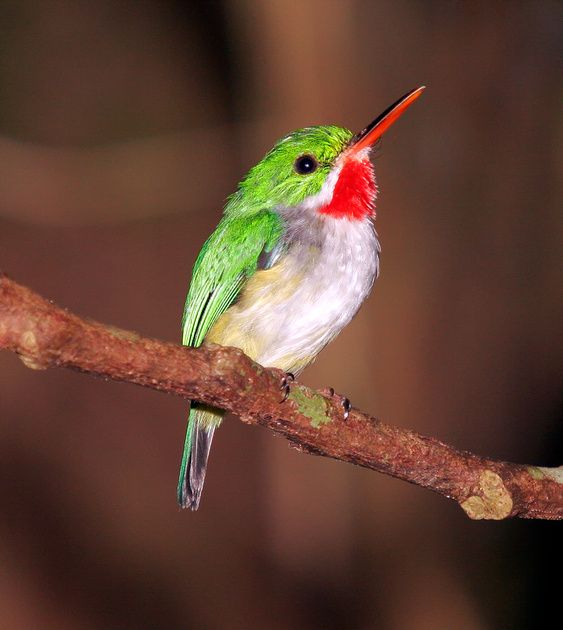The red-necked grebe (Podiceps grisegena) is a migratory aquatic bird found in the temperate regions of the northern hemisphere. Its wintering habitat is largely restricted to calm waters just beyond the waves around ocean coasts, although some birds may winter on large lakes. Red-necked Grebes are boldly plumaged waterbirds with pale cheeks and a daggerlike yellow bill that contrasts with a sharp black crown often likened to a toreador’s cap (sometimes raised into a short crest). In breeding plumage, the neck is a rich brick red. Red-necked Grebes feed by diving, then swimming beneath the water to capture prey with the bill. While resting, they often preen their plumage, sometimes swallowing the small feathers from their flanks. Red-necked Grebes form monogamous pairs, usually during stopovers on spring migration (possibly earlier), as they begin to molt into breeding plumage and commence courtship. Most arrive at breeding lakes already mated and continue their ritualized displays, called “ceremonies,” which maintain the pair bond. As with other grebes, each ceremony involves a series of stereotyped postures and movements, executed in a specific sequence. These are called the discovery ceremony, weed ceremony, and greeting ceremony. More than other grebes in the genus Podiceps, Red-necked pairs are highly vocal, giving a “whinny-braying” call during courtship and also when driving away other grebes or waterbirds from their territories. In some locations, however, pairs nest very close to one another, probably in areas where food is abundant. Aggressive behavior includes chases in which opponents patter and flap across the water, thrusting the bill forward and hunching over; and a spread-wing display in which opponents rear up on the water, facing one another. Male and female select their nest site together, and both build the nest, incubate the eggs, and care for the young. Pairs usually separate after the young are fully fledged, at about four weeks of age. Migration occurs both during the day (at least over water, as on the Great Lakes and Chesapeake Bay) and at night, sometimes in loose aggregations, as with loons. Wintering birds are usually solitary but sometimes congregate where food is plentiful or in preparation for migration. In North America, Red-necked Grebes breed chiefly in Canada and Alaska, mostly on shallow freshwater lakes in lowland areas, especially sheltered areas that have some marsh vegetation around the edges and little disturbance or human activity. Some pairs nest in small lakes, bogs, and ponds or even in large ditches or borrow pits, and some nest in wetlands of montane valleys at higher elevations. Migrants may show up on almost any body of water inland in spring or fall, though most appear on larger lakes. Wintering birds frequent mostly cold, shallow waters along ocean coastlines. Along coasts, they tend to forage more actively during higher tides. On several occasions during very cold winters, when the Great Lakes have frozen over completely, large numbers of Red-necked Grebes have appeared across eastern North America in interior locations where they’re not normally observed. Red-necked Grebes feed mostly on fish and crustaceans, along with some insects. They hunt visually in relatively clear water, from the top of the water to the bottom, if they can reach it. Sometimes, like loons, they submerge their heads partially while floating, scanning for prey, which they capture by diving and then grasping rapidly with the bill. They swallow small fish whole, headfirst, usually while still underwater. When they catch larger fish or crustaceans, Red-necked Grebes normally return to the water’s surface and prepare for swallowing the prey item by shaking and biting it. During winter, they eat fish and occasionally shrimp. When nesting, they consume almost any sort of aquatic animal or insect available, including smaller fish, salamanders, frogs (including tadpoles), amphipods, leeches, crayfish, small clams, damselflies, dragonflies, spiders, and many sorts of aquatic beetles and flies. Predators such as American crows (Corvus brachyrhynchos), common ravens (Corvus corax), gulls, bald eagles (Haliaeetus leucocephalus), American coots (Fulica americana), raccoons (Procyon lotor), minks (Neovison and Mustela), and muskrats (Ondatra zibethicus) are known to feed on red-necked grebes eggs and chicks. When small and young are not upon their parent’s back, they may be in danger of being eaten by large fish such as northern pikes (Esox lucius) and largemouth bass (Micropterus salmoides). Great horned owls (Bubo virginianus) and mink often attack adult birds while they are incubating their eggs. Parasites and roundworms can also infect this species. Some breeding pairs may also display aggressive behavior towards the young of other birds, occasionally killing another pair’s chicks. In response to predators, red-necked grebes are known to jab towards them with their bills or give a hissing call. They may also cover their eggs with nesting material before leaving their nests. Males and females give a rapid, whinnying trill that sometimes becomes a louder braying or honking (during courtship or conflict), mostly on the breeding grounds. Mated pairs sometimes purr softly, and birds warning or attacking other waterbirds occasionally hiss. Wintering birds are seldom vocal, but they may call occasionally on calm days in late winter and early spring, as the breeding season approaches. Here is a link so you can listen to this bird too.
Family
Vin deasel


